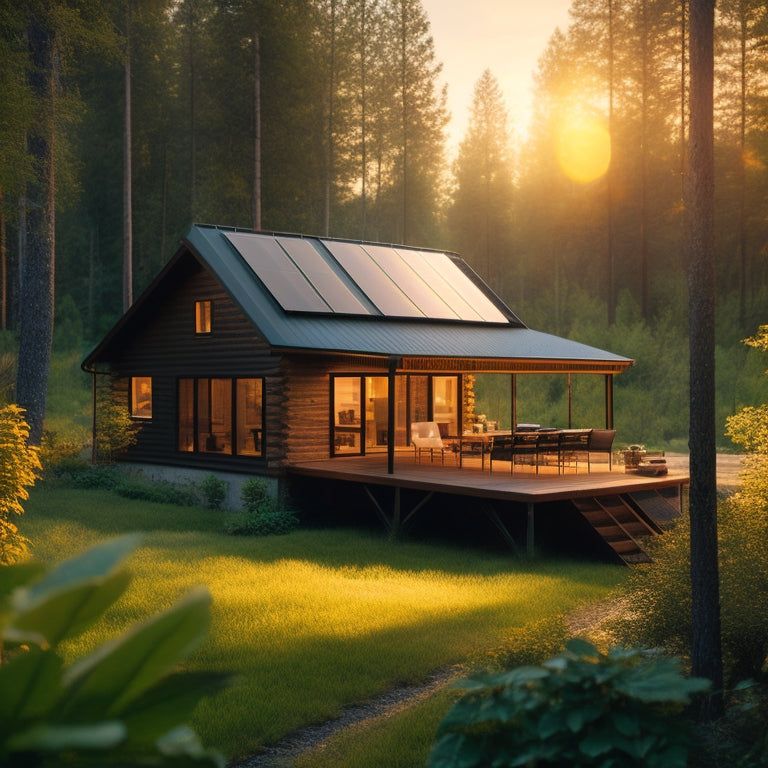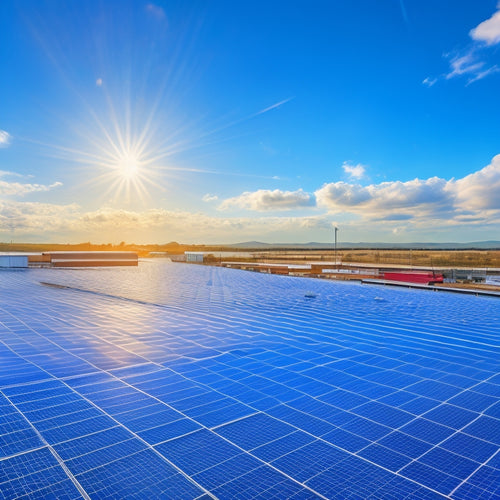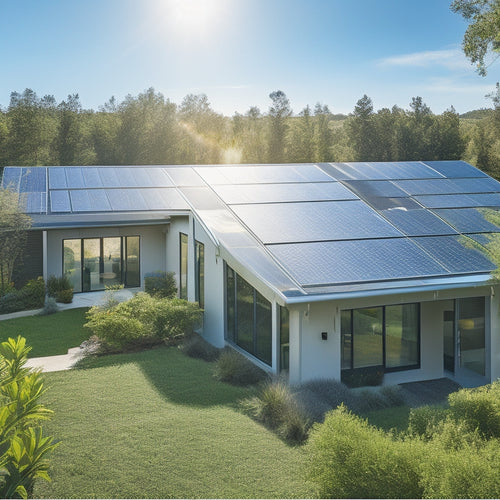
Solar for Small Cabin
Share
You can power your small cabin entirely on solar energy, eliminating utility bills and relying on a customized off-grid system designed to meet your specific energy needs. This requires careful consideration of key components like battery storage, scalability, and inverter selection, as well as a site assessment and energy monitoring. By choosing the right solar panels, energy storage options, and cabin insulation, you can achieve energy independence and greatly reduce your system's cost. With proper design and installation, you'll be able to generate electricity independently, and exploring these factors further will reveal the full potential of solar power for your small cabin.
The Essentials
- Customized off-grid solar systems are essential for small cabins, considering factors like energy needs, roof space, and local building codes.
- Solar panels, energy storage, and inverters are crucial components of an off-grid system, with options like monocrystalline and polycrystalline panels.
- Proper cabin insulation and energy-efficient appliances reduce energy consumption, enhancing system efficiency and financial freedom.
- Assessing daily energy usage patterns and calculating power requirements in watt-hours (Wh) ensures accurate system sizing and optimization.
- Maximum Power Point Tracking (MPPT) technology and high-efficiency solar panels (>20%) optimize energy yield, increasing energy independence and reducing grid reliance.
Off-Grid Energy Independence Guaranteed
You'll want to verify your off-grid system design is customized to your cabin's specific energy needs, considering factors like energy usage patterns and available roof space.
This is particularly important since traditional solar panel systems often struggle with inefficient panel configurations, leading to frequent power outages and equipment damage Off Grid Solar Panel Kits.
A well-designed system will guarantee energy independence by utilizing a reliable renewable energy source, such as solar power, to generate electricity.
Off-Grid System Design
Your cabin's remote location demands a reliable off-grid system design, where a well-planned structure is essential to utilizing renewable energy and achieving energy independence. A well-designed system guarantees that you can power your cabin efficiently, even when the grid is out of reach.
To guarantee your system meets your energy needs, consider the following key factors:
| System Component | Design Considerations |
|---|---|
| Battery Storage | Capacity, Depth of Discharge (DOD), and Type (Lead-Acid, Lithium-ion) |
| System Scalability | Modular design for easy upgrades and expansion |
| Inverter Selection | Efficiency, Power Rating, and Compatibility with Renewable Energy Source |
| Site Assessment | Shading Analysis, Energy Load Calculation, and System Sizing |
| Energy Monitoring | Real-time Energy Production and Consumption Tracking |
Properly addressing these design considerations will help you overcome installation challenges, maintain your system efficiently, and guarantee cost-effectiveness. Additionally, consider local regulations and equipment durability to guarantee your system stands the test of time. By taking these factors into account, you'll be well on your way to achieving energy independence at your cabin.
Renewable Energy Source
Most cabins situated in remote areas typically rely on solar power as their primary renewable energy source, given its abundance and reliability.
As you consider your off-grid energy independence, you'll want to investigate the various solar panel types that suit your needs. Monocrystalline and polycrystalline panels are two popular options, each with its own advantages regarding efficiency and cost.
Many cabin owners opt for off-grid solar kits that provide a reliable source of renewable energy and eliminate the noise and pollution associated with traditional power generators. Additionally, these kits offer a cost-effective and low-maintenance alternative to generators, reducing the shopper's reliance on fuel and minimizing their environmental footprint.
When selecting your solar panels, you'll also need to think about energy storage options. You'll require a battery bank that can store excess energy generated during the day for use at night or during periods of low sunlight. Lead-acid batteries, lithium-ion batteries, and saltwater batteries are popular choices, each with its own strengths and weaknesses.
As you design your renewable energy system, you'll want to carefully consider your energy needs, available roof space, and local building codes.
Zero Energy Bills Guaranteed
You'll eliminate your energy expenses entirely with a carefully designed solar system that meets your cabin's unique energy needs, leveraging off-grid systems and renewable energy to achieve independence from the grid.
This means you won't receive a utility bill, ever, and you'll enjoy zero energy costs for the life of your system.
With a solar-powered small cabin, you'll experience the financial freedom that comes with generating your own clean energy.
Zero Energy Costs
A remote cabin nestled in the woods can now be powered entirely by solar energy, eliminating the need for costly fuel deliveries and monthly utility bills. You can enjoy the freedom of living off the grid, with zero energy costs and a considerably reduced carbon footprint.
To achieve this, you'll need to evaluate various factors, including your cabin's energy requirements, available sunlight, and energy storage solutions. Here's a breakdown of the key components:
| Component | Description | Cost |
|---|---|---|
| Solar Panels | Converts sunlight into electricity | $15,000 - $30,000 |
| Energy Storage | Battery backup system for nighttime and cloudy days | $5,000 - $10,000 |
| Cabin Insulation | Proper insulation to reduce energy consumption | $2,000 - $5,000 |
| DIY Installation | DIY installation guide for solar panels and energy storage | $0 - $2,000 |
No Utility Bills
Your solar-powered cabin now generates electricity independently, freeing you from reliance on the grid and the accompanying utility bills. This means you'll no longer receive a monthly electricity bill, giving you a sense of financial freedom and independence.
With a well-designed solar array, you can utilize enough energy to power your cabin's lighting, appliances, and heating systems.
To guarantee zero energy bills, it's vital to optimize your cabin's energy efficiency. Proper cabin insulation is significant, as it reduces heat loss and keeps your cabin warm during the winter months.
Alternative heating sources, such as wood stoves or propane-powered heaters, can also be used in conjunction with your solar array to provide additional warmth.
By combining these elements, you can create a self-sustaining cabin that operates independently of the grid.
With no utility bills to worry about, you'll have more freedom to enjoy your cabin and the surrounding wilderness, without the burden of ongoing energy expenses.
Maximum Power Point Tracking
When you're investing in a solar power system for your small cabin, you want to guarantee you're getting the most out of your investment.
Since you're likely dealing with limited space, it's vital to optimize your energy yield, especially when considering rural electricity solutions.
Maximum Power Point Tracking (MPPT) is an important component that enables efficient energy harvesting by constantly monitoring and adjusting the system's voltage to optimize power output.
Efficient Energy Harvesting
Efficient Energy Harvesting (Maximum Power Point Tracking)
As you design your cabin's energy system, you need to maximize the energy output from your solar panels. Efficient energy harvesting is vital to guarantee you get the most out of your solar panel efficiency. Maximum Power Point Tracking (MPPT) is a technique that allows your solar installation to optimize energy production by tracking the maximum power point of your solar panels.
| Benefits | Description |
|---|---|
| Increased Energy Output | MPPT guarantees your solar panels operate at their maximum potential, resulting in more energy harvested. |
| Improved Energy Storage | By optimizing energy production, you can store excess energy in your energy storage solutions, providing backup power during periods of low solar radiation. |
| Enhanced Sustainability | Efficient energy harvesting promotes sustainable energy practices, aligning with your cabin lifestyle benefits and reducing your carbon footprint. |
Optimized Power Output
Maximum power point tracking (MPPT) guarantees your solar panels operate within a narrow voltage range, allowing them to produce their maximum power output. This advanced technology assures you get the most out of your solar panel system, especially during periods of low sunlight.
By constantly monitoring and adjusting the voltage, MPPT optimizes the energy harvest from your solar panels, resulting in increased solar panel efficiency.
When you pair MPPT with advanced battery storage solutions, you can store excess energy generated during the day for use at night or during power outages. This means you'll have a reliable source of energy, even when the sun isn't shining.
With MPPT, you can maximize your energy independence and reduce your reliance on the grid. By optimizing your power output, you'll be able to enjoy the freedom and self-sufficiency that comes with living off the grid.
Assess Your Energy Demands
You'll need to determine your energy usage patterns to figure out how much power you require daily.
Consider the type of devices you'll be using, such as portable power solutions and rechargeable batteries, to get an accurate estimate.
Start by calculating your daily power requirements in watt-hours (Wh) based on the appliances and devices you plan to use in your cabin.
This will help you size your solar array and battery bank correctly.
Energy Usage Patterns
Your small cabin's energy usage patterns will have an important impact on the size and cost of the solar power system you need.
Understanding your energy consumption habits is essential in determining the right system for your off-grid lifestyle.
You'll want to assess your daily routines, identifying areas where you can make lifestyle adjustments to reduce energy consumption.
For instance, consider replacing incandescent bulbs with LEDs, which use considerably less power.
You may also want to invest in energy-efficient appliances or investigate alternative methods for tasks like cooking and heating water.
Daily Power Requirements
As you strive to live off the grid, accurately evaluating your daily power requirements is vital to sizing a solar power system that meets your needs.
You'll need to calculate your total daily energy usage in watt-hours (Wh) to determine the right system size. Start by making a list of all your appliances, lights, and devices, along with their respective power consumption and usage hours. Add up the total watt-hours for each item to get your total daily energy demand.
Be sure to take into account your energy usage patterns, such as peak usage during morning and evening hours. This will help you determine the required battery storage capacity to guarantee a steady power supply throughout the day.
Effective energy management is essential to optimize your solar power system's performance. By accurately evaluating your daily power requirements, you'll be able to design a system that provides reliable energy independence and freedom from the grid.
Higher Energy Conversion Rate
You'll want to prioritize efficient panel technology to maximize your solar energy conversion rate.
Look for panels with high-efficiency ratings, typically above 20%, to guarantee you're getting the most power per hour of sunlight.
Efficient Panel Technology
Twenty-first-century innovations have markedly enhanced solar panel efficiency, allowing homeowners to generate more power from a smaller footprint.
As you consider solar for your small cabin, you'll want to prioritize efficient panel technology to maximize your energy output. Look for panels with high conversion rates, typically above 20%. These advanced panels will provide more power per unit area, reducing the overall system size and installation costs.
Additionally, consider panel durability and installation practices that guarantee peak energy production. You'll also want to think about energy storage solutions to store excess energy generated during the day for use during the night or on cloudy days.
With efficient panel technology, you'll reduce your environmental impact while enjoying cost efficiency. Take advantage of technological advancements in performance monitoring to track your system's performance and identify areas for improvement.
Frequently Asked Questions
Can I Install Solar Panels on a Metal Roof?
You can install solar panels on a metal roof, leveraging its advantages like durability and water-tightness. However, consider the installation's unique demands, such as specialized mounting systems and ensuring a watertight seal to prevent leaks.
Are Solar Panels Durable Enough for Harsh Weather?
Like a lighthouse of hope in a storm, you'll find solace in knowing solar panels are built to withstand the fury of Mother Nature. With a lifespan of 25-30 years, they're engineered to resist harsh weather conditions, ensuring your freedom from energy dependence.
Will Solar Panels Work During a Power Outage?
You'll find that solar panels won't provide power during a grid outage unless you have an off-grid system with a battery bank, ensuring continuous energy supply and high solar panel efficiency when you need it most.
Can I Add More Panels to My System Later On?
You can easily expand your solar setup in the future; just guarantee your initial system is designed with future expansion in mind, and consider energy storage options to maximize your potential for off-grid independence.
Do Solar Panels Require Regular Maintenance?
"An ounce of prevention is worth a pound of cure." You'll find that solar panels require minimal maintenance, but regular cleaning is essential to maximize energy output. Typically, you'll need to clean your panels every 6-12 months, depending on your environment and climate.
Final Thoughts
You're on the cusp of severing ties with the grid, embracing the freedom that comes with off-grid energy independence. Gone are the days of surprise energy bills, replaced by the comfort of zero energy costs. By utilizing the power of solar, you'll maximize your energy conversion rate, thanks to advanced maximum power point tracking. Assess your energy demands, and let the sun do the rest. The contrast is stark: grid dependence versus energy self-sufficiency. Choose the latter, and bask in the reliability of your small cabin's solar-powered haven.
Related Posts
-

Is This the Future of Alternative Energy Systems
Yes, alternative energy systems are shaping the future of energy. Innovations in solar and wind technologies are driv...
-

Commercial Solar Energy
As you consider powering your business with commercial solar energy, you'll uncover it offers a triple benefit: signi...
-

Installing Metal Solar Roofs for Maximum Energy Efficiency
Installing metal solar roofs can drastically enhance your home's energy efficiency and durability. These roofs withst...


